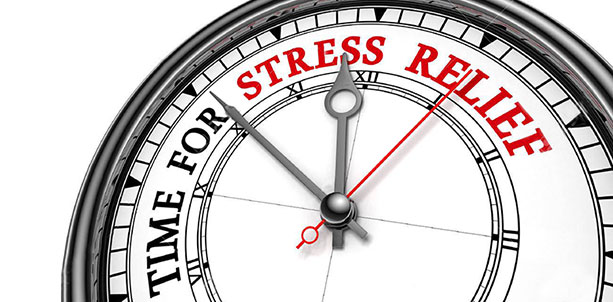Stress and Health
A strong link between physical health and stress was established more than a quarter century ago when researchers noted that exacerbation of tumor growth in rats occurred following acute exposure to uncontrollable shock but not to controllable shock. It was postulated that stress influenced neurochemical, hormonal and immunological changes that, in turn, effected the tumor growth1.
More recent research focused on the physiology of emotional response to psychosocial stimuli added to the understanding of how neurochemical, hormonal and immunological changes occur and contribute to physical and neurological dysfunction. The responses were characterized as the “defense, fight or flight” and “defeat or give up” behaviors. These limbic-hypothalamic patterns of response serve to protect a person from adverse stimuli2. Under normal circumstances a person can manage their stress but when demands exceed coping abilities, a cascade of physical and psychological events take place and illness and disease can occur, especially if left unchecked over a long period of time3,4.
Stress and Physical Illness
It is known that stress contributes to or exacerbates certain physical diseases such as diabetes, rheumatoid arthritis, peptic ulcer disease, and cardiac disease. Newer information supports the idea that not only does physical illness cause stress, but stress may bring on or worsen symptoms and disorders. Some examples are increased blood pressure and pulse rate, diarrhea, headache, chest pain, backache, depression, schizophrenia, bipolar disorder, panic disorder, post-traumatic stress disorder5,6.
Chronic medical conditions (CMC) can be caused, exacerbated and supported by stress and are a major cost-driver in developed countries. In the US, for example, the cost of treating chronic conditions constitutes 83% of total Medicaid and 96% of the total Medicare expenditures7. In some countries, healthcare costs on a person with one CMC is double that of health care costs on someone without a CMC. According to the World Health Organization (WHO) there are more than 2 billion patients with CMC worldwide and in the United States, chronic conditions account for over $1.2 trillion in health care costs annually8,9.
Patients with CMC usually have physicians who help them manage their illness. However, doctors are very limited in their ability to assess and monitor the stress and physical or symptomatic changes their patients might experience. They must rely on patients’ memory and how accurately they record, recall or communicate events. Often, the physical changes in a disease state are too subtle to even be noted by patients. Furthermore, patients with CMC are not aware of the things that trigger stress and cause their symptoms to flare.
Assessments can determine the current status of an individual’s stress as well as what activities make symptoms worse or better. Biofeedback is a process whereby a person trains their physiology and thereby self-manages their symptoms. Thus, a stress assessment and a biofeedback (SAB) system can become critically important tools for self-management of stress and ease of symptoms associated with CMC.
The majority of computer, tablet, and smart phone applications available today that are designed to improve general health do so by tracking physical activities and monitoring metrics such as heart rate, calorie consumption, weight, blood pressure and BMI. Unfortunately, these apps have a low to medium sophistication levels in terms accuracy, range of functionality, use of physiological measurements, integration of medical services and linkage to existing medical databases. The apps lack systems to track and quantify the effects of exercise, food, alcohol, sleep, and stress have on the mind and body. Most importantly, the current apps lack systems to aid use of biofeedback to manage and improve negative symptoms.
Broad use of an appropriate SAB systems will revolutionize health care. The system must be accurate, affordable and employ a convenient wearable device that measures and monitors the impact of stress on chronic conditions and symptoms in real time. By doing so, it can significantly improve the management of chronic diseases, improve clinical outcomes, increase patient/physician communication and increase quality interventions. It will collect data to trend and convert into understandable charts and graphs that give patients and their doctors methods to easily and constantly monitor how they are individually managing stress and responding to treatment. It will work with Apps that continuously monitor stress data and enable patients to log other data such as any recognized triggering events, the severity of symptoms, diet, medications, etc. Patients will be able to wear a comfortable sensor that sends ubiquitous streams of quantitative data to be transmitted, stored, analyzed, and compared with previous tests and normative data such as age and gender, then the results will be reported in forms appropriate to the user.
The SAB system should be based upon a physiological variable considered the gold standard in stress measurement: heart rate variability or HRV. This is a reliable, scientifically documented method of assessing an individual’s stress. HRV measurements quantify beat-to-beat fluctuations in heart rate and is considered an index of cardiac parasympathetic nervous system activity 10,11,12,13. In the general populations, reduced HRV has been associated with increased risk of coronary heart disease cardiac mortality14, diabetes15, depression16, and all-cause mortality17.
Two methods to measure HRV are currently commercially available. One is based upon electrocardiography (ECG) and the other is photoplethesmography (PPG) or light technology. The validity of ECG and PPG in measuring HRV variables has been compared in studies with correlations between the two reported between 90 and 97 percent depending on the condition18,19. PPG has been an important technological development because it less inexpensive than ECG to produce, less intrusive, does not require additional disposable products to capture the signal, and can be embedded into an ear clip, finger clip, clothing, or a watch.
Biofeedback training for stress management involves syncing respiration with heart rate and producing a condition referred to as respiratory sinus arrhythmia (RSA), that is known to facilitate a decrease in stress while strengthening the peripheral nervous system. To accomplish RSA a patient follows a breath-pacer set at a prescribed pace changing their HRV. Subsequently, the PNS will improve and symptoms decrease. Positive changes at increasing percentages are rewarded. The process continues until the person can achieve a high level and maintain it for increasing amounts of time. A training report is recorded and trended. Doctors can use a system like this to quickly test patients during office visits and to monitor patients with chronic conditions. Patients may use it at home as often as they want and share their measurements with the doctor. Patients can also do personalized biofeedback sharing these results as well.
In summary, it is now possible to assess stress and apply mobile-accessed biofeedback to improve symptoms and improve health. Consumers should look for a SAB system that delivers quick and frequent stress assessments using scientifically tested HRV analysis. The system should have the capability to assist individuals in learning and practicing biofeedback techniques that improve their HRV and cardiorespiratory functioning so they can prevent untoward stress and thereby ameliorate chronic illness symptoms.
References:
- Sklar, L. S. & Anisman, H. Stress and Tumor Growth. Psychological Bulletin. 1981: 89(3); 369-406.
- Folkov, B. Stress, hypothalamic function and neuroendocrine consequences. Acta Med Scand Suppl. 1988: 723; 61-69.
- McKewen BS. Biol Psychiatry, 2003 54(3):200-207.
- Kudielka, B. M. & Kirscbaum, C. Biological basis of the stress response. In al’Abasi, M. (Ed.) Stress and Addiction: Biological and Psychological mechanism. 2007; (pp. 3-18) Elsivier LTD.
- Hjemdahl, P. Stress and the metabolic syndrome. Circulation. 2002:106;2634-2636.
- Source: Does Stress Cause Psychiatric Illness? Progress in Psychiatry Carolyn M. Mazure (Ed.) American Psychiatric Publishing, Inc.; 1st ed edition (May 1995) 304 pages.
- The Mayo Clinic. Stress Management: Retrieved from internet source https://www.mayoclinic.org/healthy-lifestyle/stress-management/in-depth/hlv-20049495 on December 25, 2019.
- Centers for Disease Control and Prevention. Chronic Disease statistics. Retrieved from internet source: https://www.cdc.gov/datastatistics/index.html on November 17, 2019.
- The World Health Organization. Non-communicative diseases and their Risk Factors. Retrieved from Internet Source https://www.who.int/ncds/surveillance/en/ on November 17, 2019.
- Acharya UR, Joseph KP, Kannathal N, Lim CM, Suri JS. Heart rate variability: a review. Medical and Biological Engineering and Computing 2006; 44:1031-1051. PMID: 17111118 2.
- Routledge HC, Chowdhary S, Townend JN. Heart rate variability-a therapeutic target? Journal of Clinical Pharmacy and Therapeutics 2002; 27:85-92. 3.
- Task Force of the European Society of Cardiology the North American Society of Pacing Electrophysiology. Heart Rate Variability: Standards of Measurement, Physiological Interpretation, and Clinical Use. Circulation 1996; 93:1043-1065. PMID: 8598068 4.
- Shaffer F and Ginsberg JP. An Overview of Heart Rate Variability Metrics and Norms. Front. Public Health 2017; 5:258. doi: 10.3389/fpubh.2017.00258
- Liao D, Cai J, Rosamond WD, Barnes RW, Hutchinson RG, Whitsel EA, et al. Cardiac autonomic function and incident coronary heart disease: a population-based case-cohort study. The ARIC study. American Journal of Epidemiology 1997; 145:696-706. PMID: 9125996 5.
- de Bruyne MC, Kors JA, Hoes AW, Klootwijk P, Dekker JM, Hofman A, et al. Both decreased and increased heart rate variability on the standard 10-second electrocardiogram predict cardiac mortality in the elderly The Rotterdam Study. American Heart Journal 1999; 150:1282-1288. 6.
- Dekker JM, Schouten EG, Klootwijk P, Pool J, Swenne CA, Kromhout D. Heart rate variability from short electrocardiographic recordings predicts mortality from all causes in middle-aged and elderly men. The Zutphen Study. American Journal of Epidemiology 1997; 145:899-908. PMID: 9149661 7.
- Billman GE. Heart rate variability-a historical perspective. Frontiers in Physiology 2011; 2:1-13.
- Russoniello, C. V. (2010). A measurement of electrocardiography and photoplethesmography in obese children. Applied Psychophysiology and Biofeedback, 35, 257-259.
- Russoniello, C. V. (2013). Heart Rate Variability and Biological Age: Implications for Health and Gaming. Cyberpsychology, Behavior, and Social Networking, 16 (4), 302-308.











